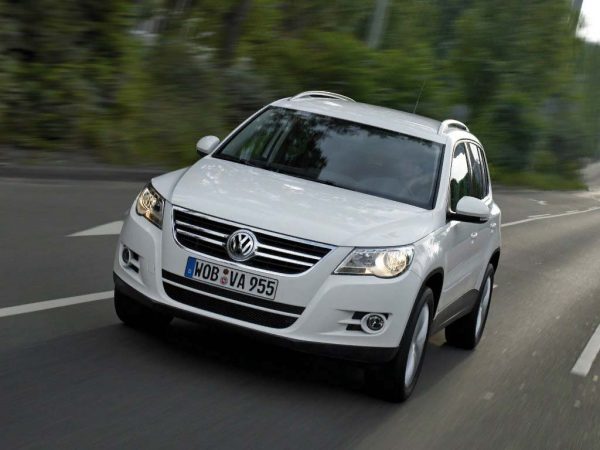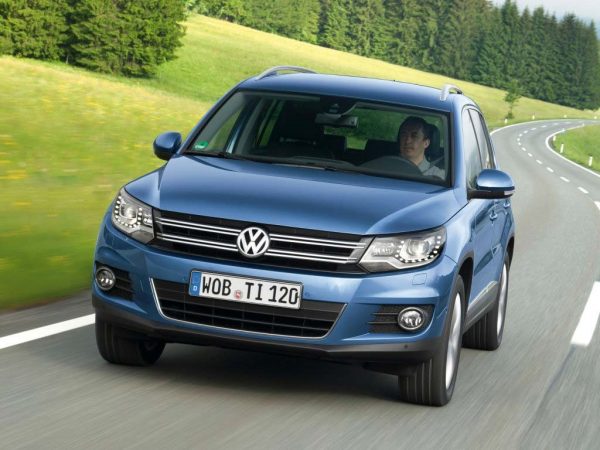
Volkswagen Tiguan 2016 - model development stages, test drives and reviews of the new crossover
Content
- Volkswagen Tiguan 1st generation, 2007-2011
- VW Tiguan I after restyling, release 2011-2017
- Features "Volkswagen Tiguan" 2nd generation, 2016 release
- Video: review of the exterior and interior of the Volkswagen Tiguan I 2011–2017, 2.0 TSI gasoline
- Video: exterior and interior, test on the track Volkswagen Tiguan I 2011-2017, 2.0 TDI diesel
- Video: overview of instruments and control functions in the 2017 Volkswagen Tiguan II
- Video: 2017-2018 Tiguan II Comparison Test: 2.0 TSI 180 HP With. and 2.0 TDI 150 horses
- Video: external and internal review of the new VW Tiguan, off-road and track testing
- 2016 Volkswagen Tiguan owner reviews
Volkswagen Tiguan of the first generation began to be assembled and sold in Russia since 2008. Then the car was successfully restyled in 2011. The second generation of the crossover is produced to this day. Good adaptability to the Russian off-road, combined with the comfort of the cabin and the economy of fuel consumption, were the reason for the popularity and high sales of this crossover.
Volkswagen Tiguan 1st generation, 2007-2011
In the middle of the last decade, the management of the VAG concern decided to produce a crossover that would become a cheaper alternative to the VW Tuareg SUV. To do this, on the basis of the Golf - PQ 35 platform, the Volkswagen Tiguan was developed and began to be produced. For the needs of the European market, production was launched in Germany and Russia. The Asian market was saturated with machines made in Vietnam and China.

Much attention is paid to the comfort of passengers in the cabin. The rear seats can move on a horizontal axis to provide comfort for tall passengers. The seat backs can also be tilted and could be folded in a 60:40 ratio, increasing the volume of the luggage compartment. The front seats were eight-way adjustable and the front passenger seat could be folded down. This was quite enough to place a long load, together with the rear seat folded down.
Serially produced front-wheel drive and all-wheel drive versions of the crossover. Reliable operation of the transmission was ensured by mechanical and automatic gearboxes with a torque converter, which had 6 switching steps. For European consumers, versions with DSG dual-clutch robotic gearboxes were also produced. The Tiguan was equipped only with turbocharged power units, which had a volume of 1.4 and 2 liters. Gasoline units had direct injection fuel systems, were supplied with one or two turbines. Power range - from 125 to 200 liters. With. Two-liter turbodiesels had a capacity of 140 and 170 horsepower. In such modifications, the model was successfully produced until 2011.
VW Tiguan I after restyling, release 2011-2017
The changes affected the exterior and interior. The car has been seriously upgraded and improved. Produced from 2011 to mid-2017. This was facilitated by great popularity in the European and Asian markets. A new dashboard was installed in the cabin, the design of the steering wheel has changed. New seats provide decent comfort for the driver and passengers. The front of the body has also changed a lot. This applies to the radiator grille and optics - LEDs appeared. Minibuses in all trim levels are equipped with electrically adjustable and heated exterior mirrors, power windows and climate control.

This version of the Volkswagen Tiguan was equipped with a large number of gasoline engines with direct fuel injection and twin turbocharging. Buyers are also offered complete sets with diesel engines. Robotic DSG boxes with six and seven gears were added to the transmissions. In addition to them, 6-speed automatic and manual boxes were traditionally installed. Both suspensions are independent. McPherson is installed in front, multi-link rear.
Features "Volkswagen Tiguan" 2nd generation, 2016 release
Tiguan II assembly began in the second half of 2016. Thus, the Kaluga plant produced two generations of this brand at once for almost a year. The previous version of the crossover was popular for a long time because it was cheaper. The second version of the SUV has undergone dramatic changes. Now the German crossover is assembled on a modular platform called MQB. This allows you to produce a regular, 5-seater and an extended, 7-seater version of the model. The SUV has become more spacious, having increased in width (300 mm) and length (600 mm), but has become a little lower. The wheelbase has also become wider.

Chassis and suspension have the same design as the previous generation Tiguan. In the Russian car market, the crossover is offered with turbocharged power plants with a volume of 1400 and 2 thousand cubic meters. cm, running on gasoline and developing a power range from 125 to 220 horsepower. There are also modifications with a diesel unit of 2 liters, 150 liters. With. In total, motorists can choose between 13 modifications of the VW Tiguan.
Standard equipment includes three-zone climate control, heated front seats and windshield washer jets, as well as LED taillights and a heated leather-wrapped multifunction steering wheel. The front seats are height adjustable. This is not all innovations, so the car is quite expensive.
Since cars of the 2016st and 2017nd generations were produced and sold during 1–2, below are videos of test drives of two generations of cars.
Video: review of the exterior and interior of the Volkswagen Tiguan I 2011–2017, 2.0 TSI gasoline
Video: exterior and interior, test on the track Volkswagen Tiguan I 2011-2017, 2.0 TDI diesel


Watch this video on YouTube
Video: overview of instruments and control functions in the 2017 Volkswagen Tiguan II


Watch this video on YouTube
Video: 2017-2018 Tiguan II Comparison Test: 2.0 TSI 180 HP With. and 2.0 TDI 150 horses


Watch this video on YouTube
Video: external and internal review of the new VW Tiguan, off-road and track testing


Watch this video on YouTube
2016 Volkswagen Tiguan owner reviews
As usual, among car owners there are those who praise and are not overjoyed with the new model, and those who expected more from an expensive crossover.
Car pluses.
Acceleration is just amazing. The car goes through deep pits, curbs, etc. remarkably well, the suspension works out absolutely silently. On fresh or just good asphalt, the noise of the wheels is not audible at all, the car seems to be hovering. The DSG box works with a bang, the switches are absolutely invisible, there is no hint of a jerk. If you do not hear a slight difference in engine speed, it seems that the speed does not change at all. 4 additional parking sensors, located on the sides of the car on the front and rear bumpers, showed themselves remarkably well. Thanks to them, there are no dead zones at all. The power tailgate is very convenient. Handling, especially in corners, is amazing - the car does not roll, the steering wheel feels great.Cons of the car.
On the old asphalt, the noise of the wheels and the work of the suspension on small irregularities (cracks, patches, etc.) are very audible. The Parking Pilot system is completely useless. After 5 minutes of driving in the parking lot at a speed of 7 km / h, he still found a place for me and parked, while missing 50 seats. Sometimes, especially when driving uphill, the box switches to an increased speed early (about 1500 rpm), which creates the illusion of a lack of power. You have to downshift. On a dirt road or small bumps, the stiffness of the suspension affects.
Here they write about the steering wheel, USB, etc. - this is all nonsense. The main drawback of the new Volkswagen Tiguan 2 is the fuel consumption of 15-16 liters. If that doesn't bother you, then I'm kind of jealous. In all other respects, the perfect crossover for the city. Optimal price-quality ratio. For six months of intense use, no questions.
In a car for 1.5 million, the button to open the 5th door completely froze (this is in frost -2 ° C), condensation formed in the rear lights. In this case, fogging of both lamps is not a warranty case. For the removal and installation of the lights and drying them on the battery for 5 hours, the officials billed 1 rubles. This is German quality. Gasoline consumption of the new Tiguan in winter (automatic, 800 l), when driving vegetables, did not fall below 2.0 l / 16.5 km. And this is after a competent break-in (no more than 100 thousand rpm for 2 km).
Liked: handling, comfort, dynamics, Shumka. Did not like: fuel consumption, no USB input on the head unit.
What impression can there be about a car that, as soon as it came out of warranty, immediately began to break down? Now running, then the damper in the engine, then the lock in the trunk lid, and so on. Further. All he knew was that he took the money for repairs on credit.
Pros: comfortable, accommodating. Disadvantages: a cylinder burned out at 48 thousand km - is this normal for a German car? Therefore, I conclude - COMPLETE SUCK! Better buy Chinese! Gluttonous - 12 liters in the city, 7-8 liters on the highway.
According to the results of test drives, the new Volkswagen Tiguan will give odds to many crossovers of the same class in terms of cross-country ability. Built-in functions that complement the transmission make driving and overcoming difficult obstacles really easy. The car is easy to control when driving on the highway, which is helped by adaptive cruise control. Therefore, most car owners believe that the model corresponds to the money invested in it.

